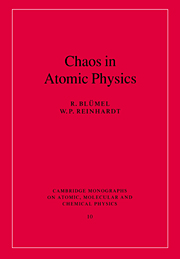Book contents
- Frontmatter
- Contents
- Preface
- 1 Introduction
- 2 Chaos: tools and concepts
- 3 Chaos in classical mechanics
- 4 Chaos in quantum mechanics
- 5 The kicked rotor: paradigm of chaos
- 6 Microwave-driven surface state electrons
- 7 The hydrogen atom in a strong microwave field
- 8 The kicked hydrogen atom
- 9 Chaotic scattering with CsI molecules
- 10 The helium atom
- 11 Chaos in atomic physics: state of the art and research directions
- References
- Index
6 - Microwave-driven surface state electrons
Published online by Cambridge University Press: 14 September 2009
- Frontmatter
- Contents
- Preface
- 1 Introduction
- 2 Chaos: tools and concepts
- 3 Chaos in classical mechanics
- 4 Chaos in quantum mechanics
- 5 The kicked rotor: paradigm of chaos
- 6 Microwave-driven surface state electrons
- 7 The hydrogen atom in a strong microwave field
- 8 The kicked hydrogen atom
- 9 Chaotic scattering with CsI molecules
- 10 The helium atom
- 11 Chaos in atomic physics: state of the art and research directions
- References
- Index
Summary
What happens if one sprinkles electrons onto the surface of liquid helium? Surprisingly the electrons are not absorbed into the bulk of the fluid, but form a quasi-two-dimensional sheet of electrons concentrated at some distance above the helium surface. In general, electrons hovering above the surface of a dielectric are called surface state electrons. An excellent review of surface state electrons is that by Cole (1974).
Surface state electrons are especially interesting in the context of chaos and quantum chaos. This is so because driven by strong microwave fields, their classical dynamics shows a transition to chaos. The investigation of microwave-driven surface state electrons as a testing ground for quantum chaos was first proposed by Jensen in 1982. So far, and to the best of our knowledge, a successful surface-state-electron (SSE) microwave ionization experiment was never carried out in the chaotic regime. This is mainly due to the formidable experimental difficulties in controlling the fragile SSE system. Electric stray fields, residual helium vapour pressure and interactions with the quantized surface modes (“ripplons”) of the liquid helium substrate make it very difficult to reach the high quantum numbers necessary for a quantum chaos experiment. It was, however, realized early on (see, e.g., Shepelyansky (1985)) that the dynamics of low angular momentum hydrogen Rydberg atoms is very similar to the dynamics of surface state electrons. Therefore, building on the knowledge accumulated in the field of surface state electrons, the focus of research shifted to the investigation of microwave-driven hydrogen and alkali Rydberg atoms.
- Type
- Chapter
- Information
- Chaos in Atomic Physics , pp. 150 - 180Publisher: Cambridge University PressPrint publication year: 1997

